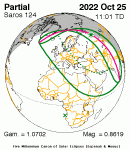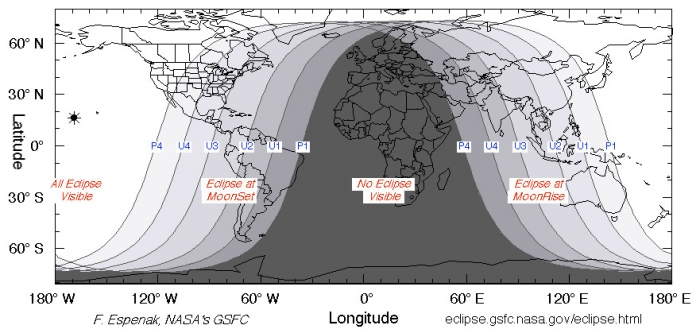2022 Sky Events
Our clockwork solar system causes celestial events to repeat with regularity from our vantage point on the Earth. This allowed ancient astronomers, from millennia ago, to predict the rising of certain stars and guess when eclipses were possible. Our abilities have just gotten better over the years, and we now predict with certainty the solar system events listed on this page.


Super and Micromoons
Due to the elliptical shape of the lunar orbit, the distance from the Earth to the Moon can vary by 50,200 km (31,200 mi). The term “Supermoon” describes a Full Moon that occurs near the Moon’s closest approach to Earth while “Micromoon” describes a Full Moon near the point furthest from the Earth. A Supermoon can be 14% bigger than a Micromoon. The difference in size is very obvious in photographic comparisons.
There is no agreed-upon definition of how close and far a Moon needs to be to qualify for any of these “Moon” titles. So the January 17, Full Moon, the smallest Moon of the year, in some sources is listed as a Micromoon but not in others. The next smallest Full Moon is the December 7 one. The three largest Moons this year follow each other on June 14, July 13, and August 12 and are in decreasing size order. Sources agree that the first two are “Super” but disagree on the third.

Lunar Eclipses
Two total lunar eclipses will grace Earth’s sky in 2022. These events last for hours, with the Moon in the deepest part of Earth’s shadow for about 90-minutes. That’s the time period that the Moon will appear red and some call it a “Blood Moon.”
The first, on May 16, will have totality visible throughout all of the Americas except Alaska and the Canadian Arctic. Iceland, the UK, the western part of Europe, central and western Africa as well as the Atlantic Ocean will have a view of totality. In the Pacific, Hawaii and areas to the east will see totality. Shut out will be most of Russia, China, India, Japan, Southeast Asia, and areas down to Australia. Other areas will see the Moon dim as it enters the Earth’s penumbra.
| Los Angeles | New York | UT | Rome | |
|---|---|---|---|---|
| Umbra 1st Contact | Moon not risen | 22:28 (Sun) | 02:27:53 (Mon) | 04:28 (Mon) |
| Mid-Eclipse | 21:11 (Sun) | 00:11 (Mon) | 04:12:42 (Mon) | Moon has set |
| Umbra Last Contact | 22:55 (Sun) | 01:55 (Mon) | 05:55:07 (Mon) | Moon has set |
The second total lunar eclipse will be on November 8. It is centered on the vast Pacific Ocean. The total phase will be visible from eastern North America to Central America and northwestern South America. China, Japan, Eastern India, Southeast Asia, and areas down to Australia will also see totality. Totality will miss Scandinavia, Europe, the Arabian Peninsula, and Africa.

Solar Eclipses
All solar eclipses need filters to observe the partial phases. There will be no total solar eclipses this year — only two partial ones.
The first event is the April 30th partial solar eclipse that will be visible from the southern part of South America, the adjoining Pacific Ocean, and down to the waters and coast of West Antarctica. The deepest eclipse of this partial event is from the tip of South America to waters west of the Antarctic Peninsula, where over half of the Sun will be covered.

The October 25 partial solar eclipse will darken the skies from the arctic to India on one side and through much of Europe, the Middle East, and the northern part of Africa to the horn on the other. The deepest part of the eclipse will be in eastern Russia and Kazakhstan. They will see about 80% of the Sun covered.

Messier Marathon
In March each year, the Sun passes through a gap in the sky that doesn’t contain any Messier objects (in Pisces / Aquarius). When the Moon is new during this gap, it is possible to observe all the Messier objects (depending on your latitude) in a one-night “Marathon” observing session. This year, the Messier Marathon window opens on March 2 — coincident with the new Moon. The Moon is again new on March 30, providing another viewing window Window for the last days of the Month. Organized Marathons will aim for the first weekend without lunar interference, which will be Saturday, March 5 (best for low latitudes) and April 5 (late, but better for higher latitudes). See this chart for the Messier Observing Window in latitude versus date form.
Planetary Pairings
We usually speak of conjunction when describing celestial bodies close together in the sky. You can start observing the following conjunctions in the days before the closest approach to see how they draw together and pass each other in the sky.

Two interesting conjunctions happen in April this year. On April 4, in the morning hours before sunrise, with brilliant Venus looking on, Saturn and Mars will be only 19-minutes of arc apart in Capricornus. This is close enough that both will fit within the same eyepiece field of view in an amateur telescope. At the end of the month on April 30, another conjunction for early risers is between the brilliant planets, Venus and Jupiter. They will become 13.8 arcminutes apart in the constellation Pisces.
May 29 finds Jupiter and Mars a little over a full Moons width apart in the morning sky. Jupiter will be a brilliant mag -2.3 while Mars will be merely bright at mag 0.7.
Planetary Oppositions
Planets in opposition are in the sky opposite the Sun when viewed from Earth. They rise at sunset and are in the sky all night. Around opposition, the planets are closest to Earth and at their brightest. This makes opposition is an opportune time to view and image a planet — especially the faint “ice giants” Uranus and Neptune. Note that only planets further away from the Sun than Earth can be in opposition (diagram right). Below are the dates of opposition for the major planets. To get the most out of opposition season for a planet, you can start observing before the opposition date as it will already appear larger than average at that time.

- August 14: Saturn
- September 16: Neptune
- September 26: Jupiter
- November 9: Uranus
- December 8: Mars
Did you observe, sketch, or image with Tele Vue gear? We’ll like your social media post on that if you tag it #televue and the gear used. Example:
#televue #tv85 #ethos #jupiter
Do you want your Tele Vue images re-posted on Tele Vue Optics’ Social Media accounts? Use this hashtag for consideration:
#RPTVO











